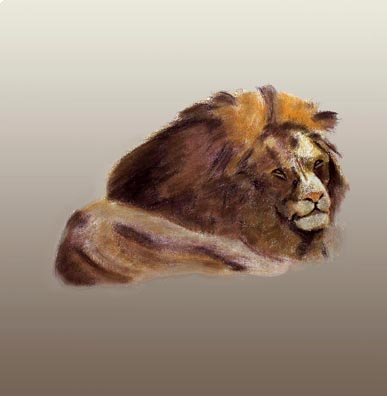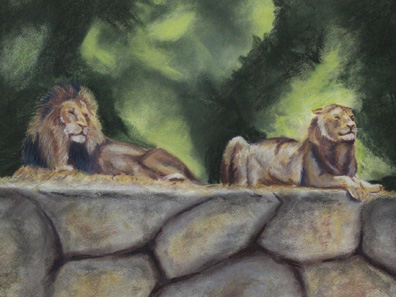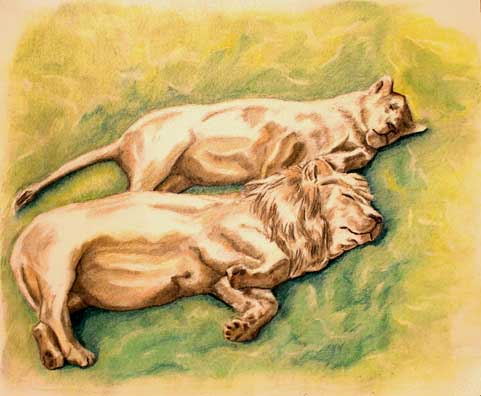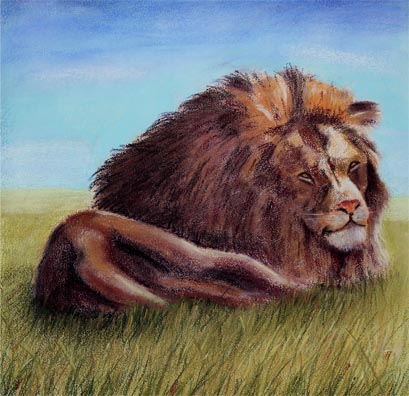Panthera Leo
Les Grands Félins

Fine Art
The Lions of Washington, D. C.
When one speaks about the African lion, the hoi polloi may sneer and say, African lions? What other kind is there? Kalamazoo lions?
Pshaw. There are indeed lions that live outside of Africa. The lion pictured on the left currently resides in Washington, D. C. The white lions shown below were taking their ease in Philadelphia. Certainly there are lions all over the world.
But if you mean lions who live in their native habitats, there are indeed lions out of Africa. Today wild lions still live in the Gir Forest in the Gujarat state of India. Properly called the Asiatic lion, their number is quite small - in the hundreds rather than thousands - and their habitat is tiny.
Unique among cats - big, little, domesticated, or wild - lions live in groups called prides. The head of a pride is the dominant male, and with one or two younger males, make it their job to defend the territory. A lion's territory can be up to 100 square miles and is often shared by other prides. Females generally stick with the pride when they grow up but the younger males go off to form their own.
What is not well known is that it is the females - the lionesses - that do most of the hunting. A hunt is usually a group effort and several lady lions will head off together while others act as baby sitters.
It appears that the lions will carefully preselect an individual before actually making an attack. They start the chase and will cut the animal from the herd before closing in.
Lions on the hunt also show considerable ingenuity. In the 1960's, observers in one of the major African parks noted the lions would wait until a group of tourists came driving slowly by. The lions would then stroll along with the cars, keeping the cars between them and the herds of the game animals. When they got close enough, the lions would bolt from the cover of the cars and charge.

Lions
The lady does the work.
Once the prey has been killed, the rest of the pride jumps in. Of course, the larger the animal the better, but in areas where big game is scarce - like the Kalahari Desert - the lions make do with what they can catch. The males usually eat first (it figures) and then go and spend the next 20 or so hours of the day asleep. Next in line for dinner are the females (the hunters), and the cubs get what's left over.
Writings from ancient historians as well as various stories, fables, and legends, attest to the wide range of the lions in historic times. During the time of Herodotus lions lived in Greece and even north and east of India.
But go back far enough and true lions, the species leo of the genus panthera, were found all over the world. In the Pleistocene period - which began about 2,000,000 years ago and ended a measly 10,000 year ago, there were lions living in North America.
The American lion was larger than their modern African cousins being closer in size to the modern Siberian tiger. They hunted large game and a mummified Pleistocene bison was found with what appeared to be tooth and claw marks from a lion.
You will read in one of the more popular books about the Roman empire that because the Romans captured so many lions for the arena it disappeared from North Africa. But could we expect anything else from those decadent orgy-loving Romans?
The truth is in 1800, the range of the lion was little changed from the previous 2000 years. Although no longer in Europe, it still ranged throughout all of Africa, the Middle East, and on into India. As late as the 1940's this had changed only slightly and lions could still be found not only throughout Africa but also in Iran, Arabia, Yemen, Oman, and what is now modern Syria, Lebanon, and Israel. There were also the lions in India. But by the 1980's the lion had disappeared from the Middle East and North Africa and by the Millennium the range had been reduced to isolated areas south of the Sahara.
People of a certain vintage will remember the African legacy of author Ernest Hemingway. From the 1930's until the 1960's, a mark of the true literary man was to get your wife's uncle to put up safari money so you could go out and bag a lion. "Hemingway Awe" (to use A. E. Hotcher's term) had its effect on other writers. Robert Ruark, the author of the good but now forgotten novel about the Kikuyu uprising, Something of Value, often was photographed decked out in his full hunting regalia. Today you have to be rich to afford the licenses needed to hunt a lion, but you can still get them.

... and Philadelphia.
What surprises you if you check the facts is 1) how many lions there were not that long ago, and 2) how few there are today. By 2015, the total wild lion population was no more than 20,000 - down from almost 500,000 in 1940. Without minimizing the effect of people shooting animals from 300 yards with telescopic rifles, there have been even more severe causes of the depletion of the lion population. Of course, poaching continues to reduce animal numbers in general, and the African civil wars that have raged for the last fifty years have decreased animal species in some areas by as much as 90%.
But what is most irreversible is the inevitable modernization of the African continent, certainly something Europeans and Americans cannot criticize without much hypocrisy. Modernization means greater longevity and numbers of the people and they have to live in more and larger towns and cities. Expanding populations also require increased agriculture and when it comes down to who's going to get the land, people or animals, there really is no contest.
So today the only tenable areas for lions to live are the African national parks. After all, regardless of how much you want to preserve the Wild Kingdom, you really can't have lions roaming through towns, farms, and ranches. Lions particularly relish bovids which include the cows, sheep, and goats most popular as livestock. People who actually live in areas where lions have strayed have pointed out that the real animals wandering around are a far cry from the lovable animated versions we see in The Lion King.

... and Illustration
That said, lions generally cause little problem compared to other animals. Hippopotamus kill more people in Africa than any other animal. Baboons have been and remain quite a maumivu katika punda in some areas. Few lions climb through your windows and open your cupboards and refrigerators and trash your house.
References and Further Reading
What is often frustrating when looking for lists of reference books - those non-electronic devices with white flappy things in the middle - is that lions are so ubiquitous in world culture that you have to weed through long lists of titles that include fiction, children's books, folk tales, and biographies of Idi Amin. But there are good books about the animal. Still, if you want to get quick information about lions, their habits, and habitat, a perusal on the Fount of All Knowledge is not a bad place to start.
The Big Cats and Their Fossil Relatives, Mauricio Anton and Alan Turner, Columbia University Press, 1997.
"The Impact of Civil War on Forest Wildlife in West Africa: Mammals in Gola Forest, Sierra Leone", Jeremy Lindsell, Erik Klop, and Alhaji Siaka, Oryx, Vol. 45, No. 1, 69-77, 2011.
The National Geographic Society has a bit about lions on it's website. In particularly, you can read:
-
"Lions", National Geographic Society, http://animals.nationalgeographic.com/animals/mammals/african-lion/
-
"Asian Lions" National Geographic Society, http://animals.nationalgeographic.com/animals/mammals/asian-lion/
-
"Declining Lions", National Geographic, http://animals.nationalgeographic.com/animals/big-cats-initiative/lion-decline-map/
"Lions of Gir Forest", Mutual of Omaha's Wild Kingdom, 1965. Presenters: Marlin Perkins, Jim Fowler; Producer: Don Meir; Location Photography: Warren Garst